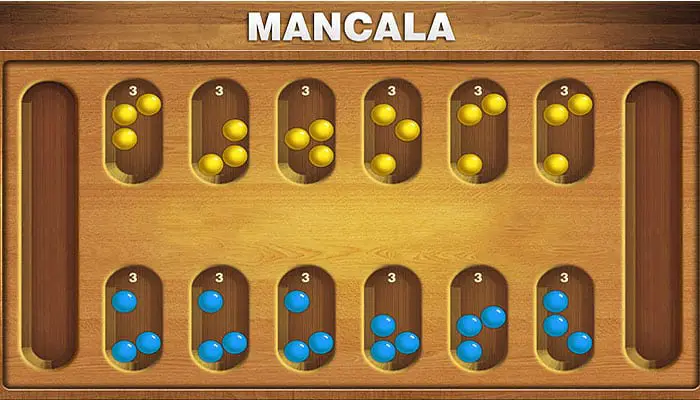

The strategy for the stone collection is to drop the seeds, which are last empty on your side of the Mancala board. Luckily it is the last stone that is left then you can get another turn and it will be the reason for your winning the game. When you are playing the game, it’s your turn to drop the seeds into the holes, and you can drop the stone into your Mancala. The methods are given in the following section: There are some ways to succeed in the match, but it requires some planning and tricks. Wins in the game depend on how someone is playing the game with proper strategy.

In this way, the score was calculated in the past and today as well. The game’s primary purpose is to gather the seeds and store them in the Mancala, but if someone cannot score in the game and gives his victory to his competitors, then the game is lost.įor example, the two players are playing, if player 1 can’t empty his turn, the opponent will collect the stone in his Mancala, but when the result occurs, player 1 is the winner because player 1 has 27 seeds while player 2 has 20. Those who fulfill the objects are considered the winner of the game. In the fourth-row games, catching the competitor or might be caught the counters in their row is the main objective. The main goal of the Mancala is to collect most of the seeds in the store, but it is the goal of the two and three rows of the games. The players maintain the inner and outer rows in a four-rank board until the competitors do not catch the seeds present in the closest two rows. Along with the two-rank board, the player’s respective side of the board needs to be protected. While the larger size of the game, Tchouba is 160 holes with 320 seeds.Įn Gehe is also playing on the rows of 50 pits with 400 seeds. The size of the board in different games varies, i.e., the game endodol is playing on the board with a size of 2×6 to 2×10. The stones or pieces are either seeds, beans, stones, half-marble, etc., which are used in the game and may fit the holes in the play. The large holes on the board are known as stores for storing or holding the pieces. The holes are also called the “pits”, “depression”, etc. The version of this game can be played on the earth surface with holes and rows. The first thing is the board, and it contains two rows with six holes or pits in it, not just a mancala board you can use any hard surface which fulfills the requirements even if the egg cart is suitable for the game. There’s not a long list of items crucial for the Mancala but some are listed here. The version of bao needed two extra holes on the surface which are at the center by the end of the pair of the rows. ► Bao: The bao is famous in Kenya and took on the board of two rows and six holes in the earth. ► Oware: It is one of the traditional mancala versions in the international competition it is played among the two players with the board, the game is primarily famous in India, west Africa. As we said, it is one of the ancient games whose variants are still famous globally.

The game takes a maximum of 10 minutes to complete many companies publish it because it is a public domain game. It is played with the stones, beans, seeds, holes, pits, rows on the earth, or any board or hard surface. Mancala is a game in which two or more two players must be included. That’s how you’ll come to know the mancala game you must give it a read to the end so that you can be skillful enough to play the game.
#Mancala rulea manual
This topic has the manual for the mancala games such as the rules, requirements, set up, tricks to win the game, how does a score calculate for the game. Mancala originated from ancient history and the game with the variation of the latest technology is still popular globally, especially in Africa and the Mideast.
#Mancala rulea how to
But most of the people don’t know how to play the game? What are the mancala rules and regulations? Go on as long as the 2 conditions are met.Mancala is one of the games that is considered helpful in building a good relationship with family and improving thinking and strength. If the previous pit is also on the opponent's side and has 2 or 3 pebbles, capture them. Sow your last pebble in a pit of the opponent containing 1 or 2 pebbles.
#Mancala rulea plus
Traditionally played in Africa (Burkina Faso, Togo, Ghana, Ivory Coast, Nigeria, Cameroon, Gabon, Senegal, Cape Verde), parts of South America (Guayana, Suriname, Brazil (current status unknown)), and the Caribbean (Antigua & Barbuda, Barbados, Dominica, Grenada, Guadeloupe, Santa Lucia, American Virgin Islands, Jamaica, Cuba) today also known in many European countries and the USA.Īwari, Awele, Awale, Aualè, Owari, Owani, Kale, Kboo, Poo, Langa Holo, Ti, Warri, Wari, Weri, Wori, Woro, Wahree, Wol, Ouril, Ouri, Ourin, Ayo, Ayoayo, A-i-ú, Adi, Adji, Adji kuiĢ rows of 6 pits, plus 2 "storage" or "scoring" pits not used during play


 0 kommentar(er)
0 kommentar(er)
